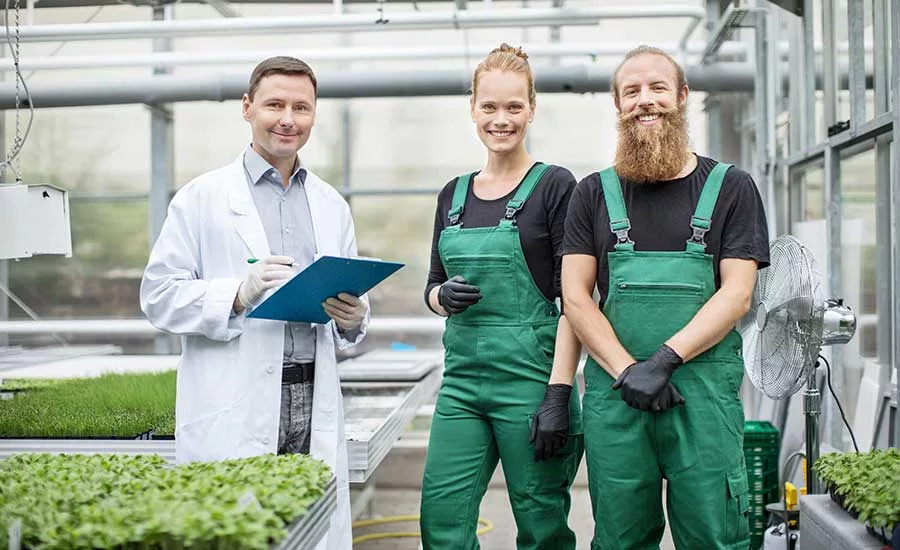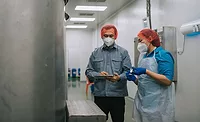Collective Responsibility for Food Safety and Quality in Food Manufacturing
Food safety and quality are not just the responsibility of one team; they are the shared responsibility of every individual within the organization

Image credit: alvarez/E+ via Getty Images
Food safety and quality are paramount in the food manufacturing industry. Ensuring that the products people consume are safe and of high quality is not solely the responsibility of a single team or department. While the food safety and quality assurance (FSQA) team plays a pivotal role, the responsibility does not rest solely on its shoulders. Food safety and quality are shared responsibilities that involve various cross-functional teams and roles throughout the organization. Fostering a food safety culture is not just a goal; it is a necessity to protect the well-being of consumers and the reputation of the company. This article delves into the various cross-functional teams and roles within a food manufacturing organization that play crucial parts in maintaining the highest standards for food safety and quality.
Fostering a Food Safety Culture
Before diving into the specific roles and teams responsible for food safety and quality, it is essential to understand the concept of fostering a food safety culture. This culture revolves around making food safety and quality a core value of the organization. It is not merely a set of rules and regulations to be followed, but rather a mindset that should permeate the entire company. A robust food safety culture is essential for protecting consumers, maintaining the company's reputation, and reducing the risk of recalls, legal liabilities, and financial losses.
A strong food safety culture emphasizes proactive rather than reactive measures. It encourages open communication, transparency, and accountability. It also promotes continuous improvement and learning from past mistakes. When everyone in the organization understands the importance of food safety and quality and is committed to upholding these standards, the company is better equipped to mitigate risks and protect its brand.
In a food manufacturing company, the FSQA team plays a crucial role in establishing and nurturing the food safety culture. This team is responsible for creating and enforcing food safety and quality policies and procedures, conducting audits, and ensuring compliance with regulatory requirements. However, its role is more of a guiding force that permeates the entire organization than a standalone entity that manages these aspects in isolation.
Responsibility Beyond the FSQA Team
To create and maintain a robust food safety culture, various teams and roles must work together harmoniously. A summary of the major responsibilities of these teams and the roles within a food manufacturing organization is outlined below.
- Senior Management and Middle Management Team
- Senior management sets the tone for the organization, emphasizing the importance of food safety and quality
- Senior management allocates resources and provides leadership support for implementing food safety practices and ensuring that food safety and quality objectives align with the company's overall mission
- Middle management plays a vital role in translating high-level objectives into practical strategies for implementation as role models.
- Product Development Team
- Ensures that new products meet food safety and quality standards from the design stage through development and production
- Designs and formulates products with food safety and quality in mind and evaluates the potential risks associated with new product ideas
- Collaborates with other cross-functional teams to address food safety concerns during product development.
- Regulatory and Technical Affairs Team
- Responsible for staying up to date on changing food safety regulations and standards and ensuring that the organization's products and processes comply with regulations
- Responsible for creating, organizing, and managing comprehensive records and documents, including product specifications, certificates of analysis, and safety data sheets
- Plays a pivotal role in obtaining necessary approvals for new products or changes to existing ones; may need to prepare and submit applications to regulatory bodies for product registrations, licenses, or certifications.
- Labeling and Packaging Management Team
- Responsible for designing product labels that are not only visually appealing but also compliant with regulatory requirements
- Ensures that labeling accurately reflects product contents, ingredient lists, nutritional facts, allergen warnings, and date of expiration and complies with regulations, minimizing the risk of mislabeling or misbranding
- Helps select appropriate packaging materials to maintain the integrity of the product, considering factors like shelf life, safety, and applicability of eco-friendly packaging solutions while ensuring that sustainability and food safety requirements are met.
- Procurement Management Team
- Select reliable suppliers and ensure the quality of raw materials, ingredients, and packaging materials
- Conduct thorough supplier audits, inspections, and ingredient risk assessments
- Manage relationships with suppliers to maintain high quality and food safety standards.
- Engineering and Maintenance Management Team
- Ensure proper hygienic design, maintenance, and servicing of equipment to prevent cross-contamination and ensure product integrity
- Implement proper sanitation guidelines and periodic maintenance per the equipment manufacturers' recommendations for machinery and equipment
- Investigate and address equipment-related food safety and quality issues.
- Food Safety and Quality Assurance Team
- Develop and implement food safety and quality programs and standards for the entire organization
- Conduct regular audits and inspections to monitor compliance to meet regulatory and GFSI schemes, as well as customer requirements and standards
- Provide comprehensive training to ensure that food safety and quality are upheld throughout the organization
- Investigate and respond to incidents, deviations, and customer complaints.
- Manufacturing and Operations Management Team
- Execute production processes in a way that ensures compliance with food safety and quality objectives and standards
- Identify and mitigate potential risks during production
- Implement quality control measures to meet product specifications and regulatory and customer requirements.
- Sanitation Management Team
- Clean and sanitize equipment and facilities to prevent cross-contamination
- Follow standardized sanitation procedures to maintain a hygienic environment
- Train employees in proper cleaning and sanitation practices.
- Marketing and Sales Management Team
- Communicate accurate and transparent information about the product attributes and the company's food safety and quality standards to customers
- Address customer inquiries and concerns regarding food safety and quality
- Collaborate with cross-functional teams to align marketing and sales strategies with food safety and quality goals.
- Warehouse and Logistics Management Team
- Handle, store, and transport products in a manner that maintains their food safety and quality
- Implement proper inventory management to prevent expired or damaged products from reaching consumers
- Collaborate with logistics teams to manage inventory rotation effectively.
- Shipping and Receiving Team
- Inspect incoming materials and products to verify their safety and quality
- Properly store and handle products to avoid contamination or damage
- Ensure that products are stored and shipped under the required temperature, time, and other conditions to maintain food safety and quality.
- Business and Information Technology Team
- Support data management, traceability, and technology solutions that aid in ensuring food safety and quality
- Implement digital solutions to track and monitor data, and provide necessary tools and systems for the teams to report and analyze safety and quality metrics
- Collaborate with cross-functional teams to develop data-driven insights for continuous improvement.
It is evident that food safety and quality are not confined to one department or team. Every member of the organization, regardless of their role, has a part to play in maintaining the high standards expected in the food manufacturing industry.
Takeaway
In every food manufacturing organization, it is a common misconception to blame the FSQA team for any issues or deviations that occur in the process or products. However, this perspective is far from the truth. Food safety and quality are everyone's responsibility. The various cross-functional teams and roles within the organization play critical parts in upholding the highest standards of safety and quality. While the FSQA team serves as the guardian and advocates for these principles, it cannot bear the entire burden alone. In a food manufacturing company, success is contingent on a holistic approach to food safety and quality.
Looking for quick answers on food safety topics?
Try Ask FSM, our new smart AI search tool.
Ask FSM →
As this article has demonstrated, numerous cross-functional teams and roles are integral in maintaining high standards for food safety and quality. Each team plays a distinct but interconnected role in this collective effort. For example, the product development team ensures that new products meet these standards, procurement ensures the sourcing of safe materials, and the marketing and sales teams communicate these standards to consumers.
To foster a mature food safety culture, it is essential to understand that food safety is not a siloed department's concern, but rather a shared commitment that extends throughout the company. Every team, from senior management to the cleaning and sanitation teams, has a role to play in ensuring that products are safe and of high quality. When these teams collaborate and work in unison, the company can better safeguard consumers and its own reputation. This collaboration mitigates risks, reduces the likelihood of incidents, and safeguards the reputation of the company. It also aligns with regulatory compliance, demonstrating a commitment to not only meeting but also exceeding the standards set by governing bodies.
In the ever-evolving landscape of food manufacturing, it is crucial to adapt, learn, and improve continuously. This can only be achieved when every member of the organization takes ownership of food safety and quality. In doing so, we can collectively ensure that the food we produce is safe, wholesome, and worthy of consumers' trust. Food safety and quality are not just the responsibility of one team; they are the shared responsibility of every individual within the organization.
Riaz Ahamadeen is Vice President of Quality/Food Safety and Regulatory–North America for Oatly. He is a highly accomplished quality, food safety, and regulatory professional with 29 years of experience in dairy, food, and beverage manufacturing, having worked for PepsiCo, TreeHouse Foods, Swiss Cheese Company, Cloverland Green Springs Dairy, Pearson's Candy Company, and Silver Spring Foods. Mr. Ahamadeen has hands-on leadership and team-building experience and is recognized as an innovative and proactive problem-solver who strives for solutions that positively influence the teams and company bottom lines.







.webp?t=1721343192)
